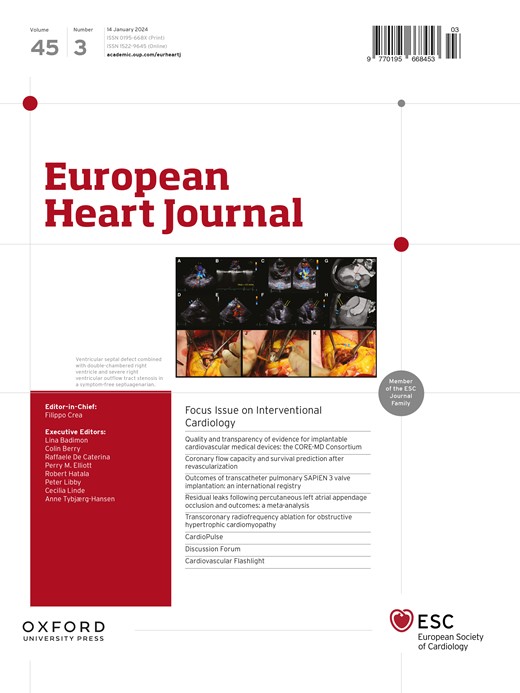血压、血浆蛋白和心血管疾病:一项孟德尔随机和观察性研究。
IF 35.6
1区 医学
Q1 CARDIAC & CARDIOVASCULAR SYSTEMS
引用次数: 0
摘要
背景和目的导致血压升高和随后的心血管疾病(cvd)的生物学途径尚不完全清楚。研究BP的蛋白质组学景观及其与CVD的重叠可以为BP调控及其对CVD的后续影响提供关键的分子决定因素和途径。方法利用遗传仪器对2007年血浆蛋白进行全蛋白质组孟德尔随机化(MR)研究,评估其对血压(收缩压和舒张压)的因果影响。进一步分析了与BP密切相关的蛋白对冠状动脉疾病(CAD)和卒中亚型的潜在因果影响。通过网络MR来估计通过BP介导的心血管疾病风险的比例。应用贝叶斯共定位来确定所识别的关联是否具有共同的因果变异。使用线性回归和Cox比例风险模型对英国生物银行参与者进行观察性关联,以评估蛋白质、血压和心血管事件之间的关联。结果蛋白质组级MR鉴定出242个与BP相关的蛋白,其中48个也与CAD或卒中相关,其中4个(ACOX1、FGF5、FURIN、MST1)也得到遗传共定位分析的支持(FDR为5%,PP≥70%)。基因预测的FURIN和FGF5与BP和卒中风险密切相关,而ACOX1、FGF5和MST1对CAD有潜在的因果影响。网络磁共振显示,它们对冠心病和卒中的很大一部分影响(30.5%-77.2%)是通过血压调节介导的。观察性分析进一步支持了这些发现。结论:本研究确定了在血压调节和CVD风险中具有潜在因果作用的关键血浆蛋白,强调了血压是其对CAD和卒中影响的主要媒介。这些发现为高血压相关心血管疾病的分子机制提供了新的见解,并为进一步研究确定了有希望的蛋白质靶点。本文章由计算机程序翻译,如有差异,请以英文原文为准。
Blood pressure, plasma proteins, and cardiovascular diseases: a network Mendelian randomization and observational study.
BACKGROUND AND AIMS
The biological pathways leading to elevated blood pressure (BP) and subsequent cardiovascular diseases (CVDs) remain incompletely understood. Investigating the proteomic landscape of BP and its overlap with CVD could provide critical insights into the molecular determinants and pathways involved in BP regulation and its subsequent effect on CVD.
METHODS
A proteome-wide Mendelian randomization (MR) study was conducted by leveraging genetic instruments from 2007 plasma proteins to assess their causal effects on BP (systolic and diastolic BP). Proteins showing strong associations with BP were further analyzed for potential causal effects on coronary artery disease (CAD) and stroke subtypes. Network MR was performed to estimate the proportion of CVD risk mediated through BP. Bayesian colocalization was applied to determine whether identified associations share common causal variants. Observational associations were examined in UK Biobank participants to assess associations between proteins, BP, and incident CVD events using linear regression and Cox proportional hazard models.
RESULTS
Proteome-wide MR identified 242 proteins associated with BP, of which 48 were also linked to CAD or stroke, with four (ACOX1, FGF5, FURIN, MST1) also supported by genetic colocalization analyses (FDR 5% and PP ≥70%). Genetically predicted FURIN and FGF5 were strongly associated with BP and stroke risk, while ACOX1, FGF5, and MST1 exhibited potential causal effects on CAD. Network MR suggested that a substantial proportion of their effect on CAD and stroke (30.5%-77.2%) was mediated through BP regulation. Observational analyses further supported these findings.
CONCLUSIONS
This study identifies key plasma proteins with potential causal roles in BP regulation and CVD risk, highlighting BP as a major mediator of their effects on CAD and stroke. These findings provide novel insights into the molecular mechanisms underlying hypertension-related CVD and identify promising protein targets for further investigation.
求助全文
通过发布文献求助,成功后即可免费获取论文全文。
去求助
来源期刊

European Heart Journal
医学-心血管系统
CiteScore
39.30
自引率
6.90%
发文量
3942
审稿时长
1 months
期刊介绍:
The European Heart Journal is a renowned international journal that focuses on cardiovascular medicine. It is published weekly and is the official journal of the European Society of Cardiology. This peer-reviewed journal is committed to publishing high-quality clinical and scientific material pertaining to all aspects of cardiovascular medicine. It covers a diverse range of topics including research findings, technical evaluations, and reviews. Moreover, the journal serves as a platform for the exchange of information and discussions on various aspects of cardiovascular medicine, including educational matters.
In addition to original papers on cardiovascular medicine and surgery, the European Heart Journal also presents reviews, clinical perspectives, ESC Guidelines, and editorial articles that highlight recent advancements in cardiology. Additionally, the journal actively encourages readers to share their thoughts and opinions through correspondence.
 求助内容:
求助内容: 应助结果提醒方式:
应助结果提醒方式:


